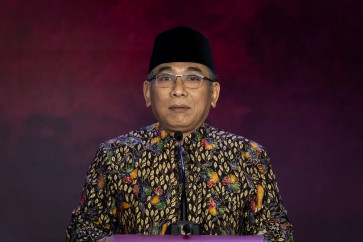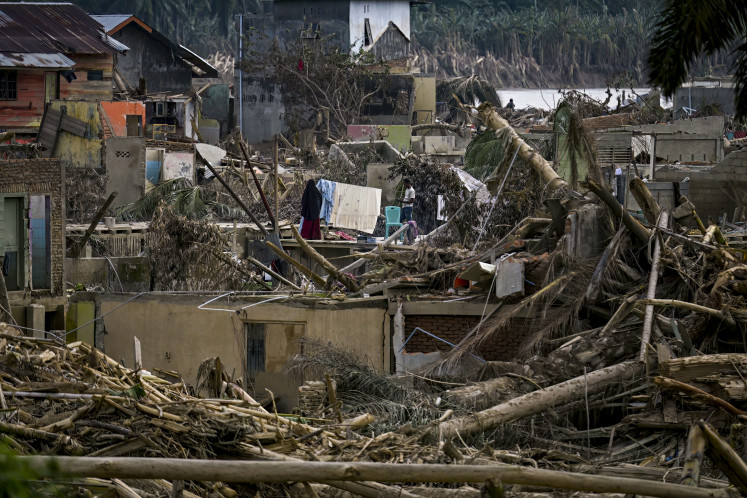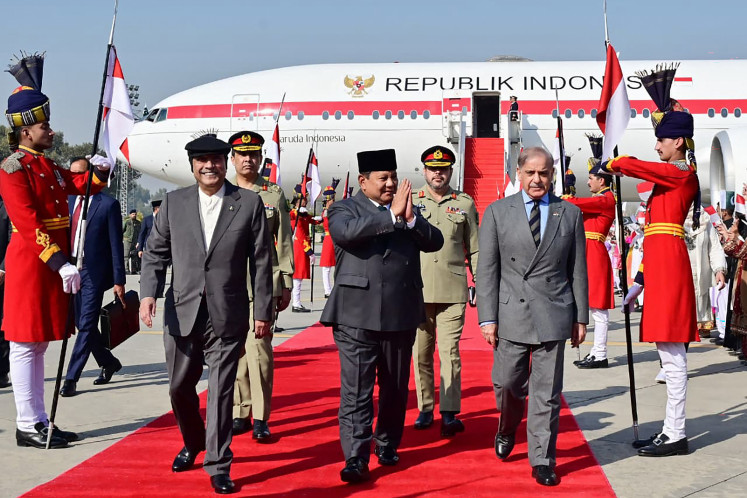Popular Reads
Top Results
Can't find what you're looking for?
View all search resultsPopular Reads
Top Results
Can't find what you're looking for?
View all search resultsRemembering a tragedy
Brutal: Trisakti Museumâs most imposing exhibit, a human-sized sculpture depicting a police officer repressing university students
Change text size
Gift Premium Articles
to Anyone
B
span class="caption">Brutal: Trisakti Museum's most imposing exhibit, a human-sized sculpture depicting a police officer repressing university students. Mark Wilson
It has been 17 years since her son, Hendriawan Sie, was gunned down by unknown assailants on the campus of Trisakti University, but for Karsiah, the pain remains as intense as ever.
'He was my only child,' says the 53-year-old. 'The burden of his death is still extremely heavy.'
On May 12, 1998, Hendriawan was shot through neck as he tried to enter one of the buildings on Trisakti's campus. Meanwhile, around him, chaos reigned.
As the country's economy crumbled, the students of Trisakti organized a 6,000-strong demonstration calling for then president Soeharto's resignation.
The students had set out on a peaceful march to the House of Representatives to push their demand, but were blocked by police and retreated to campus.
At that point, things turned ugly, with the police attacking students with firearms, tear gas and clubs. Amid the violence, 20-year-old Hendriawan and three other students were shot dead, with many others injured. The killings triggered widespread rioting and violence that eventually forced Soeharto's resignation.
For some, that represented a victory, but for Karsiah, there is only pain. Decades after the incident, she says her son's killers have still not been brought to justice.
'The other families who lost children, at least they still had other children, but for me there was only Hendriawan,' she sobs. 'They took my son. So who did this? Please can they tell me who killed my son?'
As Karsiah's wait goes on, Trisakti University is keeping alive the memories of Hendriawan and the three other slain students via the Trisakti Museum.
Who killed my son?: Fifty three-year-old Karsiah stares at a picture of her only child, Hendriawan, who was shot dead at Trisakti University on May 12, 1998. Karsiah says her son's killers have still not been brought to justice. Mark Wilson
Opened in 1999 by rector Prof. Dr. Thoby Mutis and located in the Dr. Syarif Thajeb building on the Trisakti campus in West Jakarta, the small museum takes visitors through the tragic events of May 12.
Detailed information boards, in Indonesian, give visitors a detailed hour-by-hour account of the events that led to the violence on campus, including photographs taken by students on the day.
The boards tells of how proceedings started out well, but descend into one of violence, culminating in security personnel shooting at students inside the campus and students fleeing into classrooms or prayer rooms, turning off the lights to conceal themselves and only emerging after a university dean strikes a deal with the police for the students to leave campus safely.
For foreign visitors who cannot read Indonesian, a well-informed, English-speaking university official ' Trisakti information and publications chief Bambang Heri Wachyanto ' is on hand to help.
The slain students are rightly the focus of the museum. Tables with glass compartments show their university uniforms, schoolwork and artwork, giving visitors insights into their short lives.
Trisakti's heroes: The four students who were shot dead at Trisakti University on May 12, 1998 are the focus of the museum. Mark Wilson
On one wall, four photographs of the murdered students can be seen, giving the museum an eerie feel as the four stare back at visitors, their faces seemingly searching for reasons why they were killed.
Ominous paintings from one of the university's art professors hang from the same wall in remembrance of the tragedy. As Bambang explains, one is titled 'Bullets for my son'.
In the center of the one-room museum is perhaps its most imposing exhibit, a life-sized sculpture depicting a police officer brutally repressing two students.
Bambang then points out an otherwise nondescript window. 'You should take a look at that,' he says. 'That bullet hole is real.'
He explains that in the violence of May 12, the building was shot at and this is the proof ' a glass window with a bullet hole in it. Visitors can follow the trajectory of the bullet to the opposite wall of the museum.
Bambang then walks into the parking lot outside where he points out where the four students were shot. Each location is marked with a plaque containing the name of the student and the words 'hero of reformation'.
Meanwhile, in the corner of the parking lot stands the silver-colored Trisakti tragedy monument, which has four large holes in it, each to mark the death of each student.
'This museum is very important for not only remembering the students who died, but also remembering what the wider student movement stood for and what it was trying to accomplish,' says Bambang.
'It's important for younger Indonesians and future generations to know what happened here.'
The museum, located at Trisakti University at Jl. Kyai Tapa No. 1 in Grogol, West Jakarta, is open Monday to Friday from 9 a.m. to 3 p.m. Admission is free.
You're going nowhere: Police officers form a line on May 12, 1998 in West Jakarta. The police blocked the students of Trisakti University from advancing to the House of Representatives, where the latter intended to demand that then president Soeharto step down. Trisakti University Public Relations Office
After the killing: The blood of a slain student stains the pavement outside the Dr Syarif Thajeb building of Trisakti University in West Jakarta, on May 12, 1998.Trisakti University Public Relations Office















